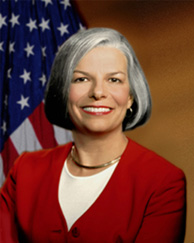 |
Julie Gerberding, M.D. |
“Nebraska is a leader in bioterrorism preparedness and this collaborative effort is another shining example of what can be accomplished by working together,” Gov. Heineman said. “I am especially pleased that Dr. Gerberding is with us today for the ribbon cutting to see for herself this first-of-its-kind state resource.”
There are only two other biocontainment patient care units in the country. The U.S. Army Medical Research Institute of Infectious Diseases houses a two-bed special Bio-safety patient care suite at Ft. Detrick, Md., for military members and investigators who may be exposed to infectious agents, and the CDC has a two-bed unit at Emory University Hospital in Atlanta.
The Nebraska Health and Human Services System (HHSS), the University of Nebraska Medical Center (UNMC) and The Nebraska Medical Center worked together to develop Nebraska’s unit, which is equipped to safely care for people exposed to highly contagious and dangerous diseases. The funding comes from federal bioterrorism dollars allocated to Nebraska, along with contributions from The Nebraska Medical Center and UNMC.
“This partnership has resulted in the development of a unit that could prove invaluable not only in the event of a bioterrorism incident, but for any public health emergency and even routine care involving infectious diseases,” said Nebraska’s Chief Medical Officer Richard Raymond, M.D. “This is an important step toward protecting vulnerable patients and the public.”
The decision to use part of Nebraska’s federal bioterrorism funding to construct the nation’s first 10-bed unit grew from the existing successful collaboration between HHSS, UNMC, and The Nebraska Medical Center.
“The dedication of this new unit is yet another bold testament to Nebraska’s commitment to preparedness,” Dr. Gerberding said. “This state-of-the-art facility with its dedicated staff will serve our country well in the event of an attack involving bioterrorism.”
Said Glenn Fosdick, president and CEO of The Nebraska Medical Center: “This unit allows us the opportunity to help hospitals across the country care for patients who come into contact with deadly, highly contagious diseases. If an outbreak occurs in another state, we will be here ready and able to take patients who need this specialized care.”
Harold M. Maurer, M.D., chancellor of UNMC, said, “We are honored to have Dr. Gerberding visit us. The Biocontainment Unit is a model of partnerships between the state and the University of Nebraska that will help improve community readiness for terrorism and naturally occurring public health threats. UNMC welcomes more opportunities to use our resources and experts in overcoming obstacles to our nation’s security.”
The new unit, located in University Tower, is on the same campus as the state’s Bio-safety Level-3 laboratory. The collocation will allow timely diagnosis and treatment of patients who come into contact with diseases like smallpox, the plague, avian flu, SARS, or botulism.
Steven Hinrichs, M.D., professor of pathology and microbiology and director of the University of Nebraska Center for Biosecurity, said the collocation is an important benefit to the state. “The Nebraska Public Health Laboratory brings state and university expertise and resources together in a collaborative effort,” he said. “The laboratory’s nearby location provides state of the art services to the biocontainment facility and enhances our overall bioterrorism preparedness.”
Said Philip Smith, M.D., medical director of the Biocontainment Unit: “The unit is a valuable regional – and potentially national – resource that is unique because of its 10-bed size and because it is a health department initiated project with collaboration between public health, a university and a hospital.”
Registered nurse Pat Lenaghan helped design the unit and now runs it. “Our staff is on-call 24 hours a day, 7 days a week,” she said. “We have 15 registered nurses and 14 respiratory therapists and techs, all of whom volunteered to staff the unit. They could care for patients ranging in age from infants to the elderly, regardless of whether they need advanced life support or observation.”
Construction on the unit began in July 2004 and was completed this month. It is equipped with special air-handling systems and many safety features designed to keep germs inside the unit and protect people on the outside. The unit also has two video phones to facilitate doctor/patient consultations and give families a connection to loved ones inside the unit.
Also visiting is Charles Schable, director of the CDC’s Office of Terrorism Preparedness and Emergency Response, and director of the CDC’s Agency for Toxic Substances and Disease Registry.